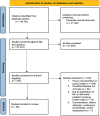Bias in machine learning applications to address non-communicable diseases at a population-level: a scoping review
- PMID: 39732655
- PMCID: PMC11682638
- DOI: 10.1186/s12889-024-21081-9
Bias in machine learning applications to address non-communicable diseases at a population-level: a scoping review
Abstract
Background: Machine learning (ML) is increasingly used in population and public health to support epidemiological studies, surveillance, and evaluation. Our objective was to conduct a scoping review to identify studies that use ML in population health, with a focus on its use in non-communicable diseases (NCDs). We also examine potential algorithmic biases in model design, training, and implementation, as well as efforts to mitigate these biases.
Methods: We searched the peer-reviewed, indexed literature using Medline, Embase, Cochrane Central Register of Controlled Trials and Cochrane Database of Systematic Reviews, CINAHL, Scopus, ACM Digital Library, Inspec, Web of Science's Science Citation Index, Social Sciences Citation Index, and the Emerging Sources Citation Index, up to March 2022.
Results: The search identified 27 310 studies and 65 were included. Study aims were separated into algorithm comparison (n = 13, 20%) or disease modelling for population-health-related outputs (n = 52, 80%). We extracted data on NCD type, data sources, technical approach, possible algorithmic bias, and jurisdiction. Type 2 diabetes was the most studied NCD. The most common use of ML was for risk modeling. Mitigating bias was not extensively addressed, with most methods focused on mitigating sex-related bias.
Conclusion: This review examines current applications of ML in NCDs, highlighting potential biases and strategies for mitigation. Future research should focus on communicable diseases and the transferability of ML models in low and middle-income settings. Our findings can guide the development of guidelines for the equitable use of ML to improve population health outcomes.
Keywords: Artificial intelligence; Machine learning; Non-communicable disease; Population health.
© 2024. The Author(s).
Conflict of interest statement
Declarations. Ethics approval and consent to participate: Not applicable. Consent for publication: Not applicable. Competing interests: The authors declare no competing interests.
Figures
References
-
- World Health Organization. Noncommunicable diseases. World Health Organization; 2022. https://www.who.int/news-room/fact-sheets/detail/noncommunicable-diseases.
-
- Artificial intelligence and data technology provide smarter health care – 4 solutions that have made a difference for noncommunicable diseases. Available from: https://www.who.int/europe/news/item/14-12-2021-artificial-intelligence-.... Cited 2023 Oct 4.
-
- Thrall JH, Li X, Li Q, Cruz C, Do S, Dreyer K, et al. Artificial intelligence and machine learning in radiology: opportunities, challenges, pitfalls, and criteria for success. J Am Coll Radiol. 2018;15(3):504–8. - PubMed
-
- Berente N, Bin Gu, Recker J, Santhanam R. Managing artificial intelligence. Manage Inform Syst Q. 2021;45(3):1433–50.
Publication types
MeSH terms
Grants and funding
- #460906/Canadian Institutes for Health Research
- #460906/Canadian Institutes for Health Research
- #460906/Canadian Institutes for Health Research
- #460906/Canadian Institutes for Health Research
- #460906/Canadian Institutes for Health Research
- #460906/Canadian Institutes for Health Research
- #460906/Canadian Institutes for Health Research
- #460906/Canadian Institutes for Health Research
- #460906/Canadian Institutes for Health Research
- #460906/Canadian Institutes for Health Research
- #460906/Canadian Institutes for Health Research
- #460906/Canadian Institutes for Health Research
- #460906/Canadian Institutes for Health Research
- #460906/Canadian Institutes for Health Research
- #460906/Canadian Institutes for Health Research
- #460906/Canadian Institutes for Health Research
- #460906/Canadian Institutes for Health Research
- #460906/Canadian Institutes for Health Research
- #460906/Canadian Institutes for Health Research
- #460906/Canadian Institutes for Health Research
- #460906/Canadian Institutes for Health Research
- #460906/Canadian Institutes for Health Research
- #460906/Canadian Institutes for Health Research
- 950-23264/Canada Research Chairs
LinkOut - more resources
Full Text Sources



